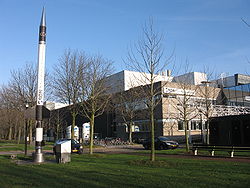- Netherlands Institute for Space Research
-
SRON Netherlands Institute for Space Research
Ruimteonderzoeksinstituut SRON
Established 1983 Headquarters Utrecht Administrator Rens Waters (Scientific Director) Website www.sron.nl SRON Netherlands Institute for Space Research is the Dutch expertise institute for space research. The Institute develops and uses innovative technology for groundbreaking research in space, focusing on astrophysical research, Earth science and planetary research. In addition to this, SRON has a line of research into new and more sensitive sensors for X-rays and infrared radiation.
SRON was founded in 1983 under the former names Stichting Ruimteonderzoek Nederland / Space Research Organisation Netherlands. SRON is part of the Netherlands Organisation for Scientific Research NWO and has a facilities in Utrecht and in Groningen.
Contents
Science and technology
The institute has about 200 staff who are employed at a support department and five divisions: High-Energy Astrophysics (HEA), Low-Energy Astrophysics (LEA), Earth and Planetary Science (EPS), Sensor Research and Technology (SR&T) and Engineering Division (ED). Together they form a unique melting pot of top scientists and technologists who inspire each other to perform at their absolute best. Problems faced by scientists challenge sensor developers to construct increasingly more sensitive technology. Together with mechanical and electronic engineers they ultimately develop a scientific space instrument with an exceptional level of performance under the extreme conditions of space. The scientific breakthroughs made with such devices in turn inspire new research and new technology, usually in cooperation with national and international partners.
Groundbreaking technology
SRON’s ambition is to act as leading institute in the development of state-of-the-art satellite instruments for space research missions of ESA, NASA and other agencies. Through the years SRON technology has contributed to many ground-breaking space missions, mainly dedicated to mapping the infrared sky (e.g. IRAS, ISO, HIFI/Herschel), analyzing X-ray and gamma ray sources (e.g. CGRO/COMPTEL, Beppo-SAX, Chandra, XMM-Newton) and studying the Earth atmosphere (SCIAMACHY/ENVISAT). Examples of future missions to which SRON will contribute are SPICA (infrared), ASTRO-H (X-ray) and Sentinel 5 Precursor (Earth atmosphere). The institute is also planning contributions to missions which will study other planets in our solar system and beyond.
Missions and projects
Current missions or projects with SRON contribution
- Chandra X-Ray Observatory & (LETG)
- XMM-Newton (& RGS)
- INTEGRAL
- Astro-H (& SXS)
- IXO
- Herschel Space Observatory & HIFI
- SPICA (& SAFARI)
- ALMA
- Envisat (& SCIAMACHY)
- Sentinel 5-Precursor (& TROPOMI)
- GOCE
- ERS-2
- MetOp (GOME-2)
- SPEX - Spectropolarimeter for Planetary EXploration
Previous missions/projects
Technology development
In various wavelength areas SRON’s sensors are already some of the most sensitive in the world. However, SRON is continuously looking for new ways to deploy even more sensitive sensors for the improved detection of cosmic radiation or for measurements of the atmosphere of the Earth and other planets. This requires longterm investments in the development of new sensors, electronics and specialist techniques. In the near future detectors shall increasingly take the shape of large chips with many megapixels, with a unique combination of two dimensional pictures and spectroscopy color resolving power.
These detectors require the development of new advanced electronics, smart control software, extreme cooling techniques and novel materials. Moreover, SRON has considerable experience in the area of mechanical constructions and electronics for applications in space. SRON has the necessary knowledge, experience and lithographical and other facilities to realise this and to work in accordance with the most stringent requirements that prevail in space technology.
SRON is working hard on the development of a new generation of detectors, and the necessary read-out and control electronics, for international missions in the submillimeter and far-infrared areas. For example, such extremely sensitive detectors are needed in SPICA/ SAFARI so that we can learn more about protoplanetary discs and the formation of planets. For SPICA/ SAFARI SRON is currently working on Transition Edge Sensors (TES).
National and international partners
Customers are on the one hand the international organizations with which SRON cooperates in bilateral, European or global projects. On the other hand, there is science as the customer: in each project, scientist are involved who in their turn pay allegiance to their university. SRON has in this way ties with the Universities in Utrecht, Groningen and Leiden, and outside the Dutch borders for example with DLR.
See also
External links
Public sector space agencies Africa North AfricaSub-SaharanAmericas North AmericaSouth AmericaAsia East AsiaSoutheast AsiaSouth AsiaSouthwest AsiaCentral AsiaEurope Oceania World See also: Timeline of first orbital launches by country · 1 Preceded by the Soviet space program Categories:- Science and technology in the Netherlands
- Space agencies
- 1983 establishments in the Netherlands
Wikimedia Foundation. 2010.


